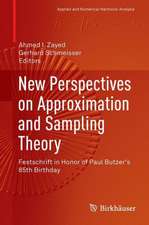Structured Population Models in Biology and Epidemiology: Lecture Notes in Mathematics, cartea 1936
Editat de Pierre Magal Contribuţii de P. Auger Editat de Shigui Ruan Contribuţii de M. Ballyk, R. Bravo de la Parra, W.-E. Fitzgibbon, S.A. Gourley, D. Jones, M. Langlais, R. Liu, M. Martcheva, T. Nguyen-Huu, J.-C. Poggiale, E. Sánchez, H.L. Smith, H.R. Thieme, G.F. Webb, J. Wuen Limba Engleză Paperback – 30 apr 2008
Din seria Lecture Notes in Mathematics
- 17%
 Preț: 360.43 lei
Preț: 360.43 lei -
 Preț: 459.92 lei
Preț: 459.92 lei -
 Preț: 121.41 lei
Preț: 121.41 lei -
 Preț: 175.68 lei
Preț: 175.68 lei -
 Preț: 197.00 lei
Preț: 197.00 lei -
 Preț: 279.76 lei
Preț: 279.76 lei -
 Preț: 477.66 lei
Preț: 477.66 lei - 17%
 Preț: 361.89 lei
Preț: 361.89 lei -
 Preț: 252.37 lei
Preț: 252.37 lei -
 Preț: 353.99 lei
Preț: 353.99 lei -
 Preț: 138.88 lei
Preț: 138.88 lei -
 Preț: 152.61 lei
Preț: 152.61 lei -
 Preț: 116.67 lei
Preț: 116.67 lei -
 Preț: 102.77 lei
Preț: 102.77 lei - 17%
 Preț: 365.53 lei
Preț: 365.53 lei -
 Preț: 396.76 lei
Preț: 396.76 lei - 17%
 Preț: 362.15 lei
Preț: 362.15 lei -
 Preț: 396.13 lei
Preț: 396.13 lei -
 Preț: 357.80 lei
Preț: 357.80 lei - 17%
 Preț: 362.31 lei
Preț: 362.31 lei -
 Preț: 403.81 lei
Preț: 403.81 lei - 17%
 Preț: 361.73 lei
Preț: 361.73 lei -
 Preț: 499.87 lei
Preț: 499.87 lei -
 Preț: 457.03 lei
Preț: 457.03 lei -
 Preț: 395.91 lei
Preț: 395.91 lei -
 Preț: 459.00 lei
Preț: 459.00 lei -
 Preț: 487.57 lei
Preț: 487.57 lei -
 Preț: 424.01 lei
Preț: 424.01 lei -
 Preț: 487.57 lei
Preț: 487.57 lei -
 Preț: 330.55 lei
Preț: 330.55 lei -
 Preț: 325.75 lei
Preț: 325.75 lei -
 Preț: 350.30 lei
Preț: 350.30 lei -
 Preț: 331.31 lei
Preț: 331.31 lei -
 Preț: 408.37 lei
Preț: 408.37 lei -
 Preț: 328.25 lei
Preț: 328.25 lei -
 Preț: 421.28 lei
Preț: 421.28 lei -
 Preț: 276.08 lei
Preț: 276.08 lei -
 Preț: 424.60 lei
Preț: 424.60 lei -
 Preț: 422.05 lei
Preț: 422.05 lei -
 Preț: 505.01 lei
Preț: 505.01 lei -
 Preț: 422.05 lei
Preț: 422.05 lei -
 Preț: 274.93 lei
Preț: 274.93 lei -
 Preț: 335.16 lei
Preț: 335.16 lei -
 Preț: 422.27 lei
Preț: 422.27 lei -
 Preț: 497.49 lei
Preț: 497.49 lei -
 Preț: 272.81 lei
Preț: 272.81 lei -
 Preț: 428.04 lei
Preț: 428.04 lei -
 Preț: 376.22 lei
Preț: 376.22 lei -
 Preț: 427.10 lei
Preț: 427.10 lei -
 Preț: 325.92 lei
Preț: 325.92 lei
Preț: 389.70 lei
Nou
Puncte Express: 585
Preț estimativ în valută:
74.57€ • 77.86$ • 61.58£
74.57€ • 77.86$ • 61.58£
Carte tipărită la comandă
Livrare economică 15-29 aprilie
Preluare comenzi: 021 569.72.76
Specificații
ISBN-13: 9783540782728
ISBN-10: 3540782729
Pagini: 344
Ilustrații: XII, 302 p. 63 illus., 32 illus. in color.
Dimensiuni: 155 x 235 x 13 mm
Greutate: 0.45 kg
Ediția:2008
Editura: Springer Berlin, Heidelberg
Colecția Springer
Seriile Lecture Notes in Mathematics, Mathematical Biosciences Subseries
Locul publicării:Berlin, Heidelberg, Germany
ISBN-10: 3540782729
Pagini: 344
Ilustrații: XII, 302 p. 63 illus., 32 illus. in color.
Dimensiuni: 155 x 235 x 13 mm
Greutate: 0.45 kg
Ediția:2008
Editura: Springer Berlin, Heidelberg
Colecția Springer
Seriile Lecture Notes in Mathematics, Mathematical Biosciences Subseries
Locul publicării:Berlin, Heidelberg, Germany
Public țintă
ResearchCuprins
Population Models Structured by Age, Size, and Spatial Position.- Infinite ODE Systems Modeling Size-Structured Metapopulations, Macroparasitic Diseases, and Prion Proliferation.- Simple Models for the Transmission of Microparasites Between Host Populations Living on Noncoincident Spatial Domains.- Spatiotemporal Patterns of Disease Spread: Interaction of Physiological Structure, Spatial Movements, Disease Progression and Human Intervention.- Aggregation of Variables and Applications to Population Dynamics.- The Biofilm Model of Freter: A Review.
Notă biografică
Pierre Magal is an Associate Professor of Mathematics at the University of Le Havre, France. He received the Ph.D. degree (1996) in applied mathematics from the University of Pau, France and the HDR (2003) in applied mathematics from the University of Le Havre, France. His research interests include semigroup theory, population dynamics, and mathematical biology.
Shigui Ruan is a Professor of Mathematics at the University of Miami, Coral Gables, USA. He received the Ph.D. degree (1992) in applied mathematics from the University of Alberta, Edmonton, Canada. He was a Junior Fellow at the Fields Institute, Toronto, Canada in1992-1993 and a postdoctoral fellow at McMaster University, Hamilton, Canada in 1993-1994. From 1994 to 2002, he was an Assistant and Associate Professor at Dalhousie University, Halifax, Canada. His research interests are Differential Equations, Dynamical Systems, and Mathematical Biology.
Shigui Ruan is a Professor of Mathematics at the University of Miami, Coral Gables, USA. He received the Ph.D. degree (1992) in applied mathematics from the University of Alberta, Edmonton, Canada. He was a Junior Fellow at the Fields Institute, Toronto, Canada in1992-1993 and a postdoctoral fellow at McMaster University, Hamilton, Canada in 1993-1994. From 1994 to 2002, he was an Assistant and Associate Professor at Dalhousie University, Halifax, Canada. His research interests are Differential Equations, Dynamical Systems, and Mathematical Biology.
Textul de pe ultima copertă
This book consists of six chapters written by leading researchers in mathematical biology. These chapters present recent and important developments in the study of structured population models in biology and epidemiology. Topics include population models structured by age, size, and spatial position; size-structured models for metapopulations, macroparasitc diseases, and prion proliferation; models for transmission of microparasites between host populations living on non-coincident spatial domains; spatiotemporal patterns of disease spread; method of aggregation of variables in population dynamics; and biofilm models.
It is suitable as a textbook for a mathematical biology course or a summer school at the advanced undergraduate and graduate level. It can also serve as a reference book for researchers looking for either interesting and specific problems to work on or useful techniques and discussions of some particular problems.
It is suitable as a textbook for a mathematical biology course or a summer school at the advanced undergraduate and graduate level. It can also serve as a reference book for researchers looking for either interesting and specific problems to work on or useful techniques and discussions of some particular problems.
Caracteristici
Includes supplementary material: sn.pub/extras










